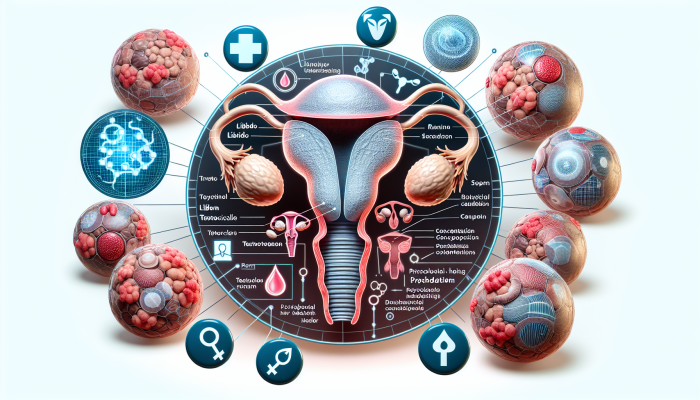Understanding Testosterone Testing Standards for Optimal Health Management
Testosterone is often considered a key player in the realm of hormonal health, impacting not just men but also women. This essential steroid hormone is crucial for muscle growth, sexual drive, bone health, and emotional stability. Maintaining an optimal balance of testosterone levels significantly enhances life quality, influencing factors such as energy levels, mood, and cognitive abilities. Thus, a comprehensive understanding of the testosterone testing standards is vital for detecting imbalances and optimizing your overall health and well-being.
Key Insights on the Role of Testosterone in Health

The majority of testosterone is synthesized in the testicles for men, while women produce it in smaller amounts through the ovaries. Although commonly associated with male traits like muscle mass and body hair, testosterone plays a vital role in various bodily functions for both sexes. Testosterone levels can greatly affect libido, sperm production, and cognitive functions such as concentration. Insufficient testosterone can lead to numerous health challenges, including depression, chronic fatigue, and diminished sexual performance, emphasizing the importance of maintaining balanced hormone levels.
Moreover, the implications of testosterone extend into the psychological realm. Research demonstrates that adequate testosterone levels can enhance mood stability and provide greater resilience against stressors. This highlights the necessity of monitoring and comprehending your testosterone levels, especially if you observe notable changes in your overall emotional and physical well-being.
How Testosterone Testing Standards Are Developed and Defined
The testosterone testing standards are established based on extensive clinical research conducted on healthy individuals across diverse demographics. These studies take into account a variety of factors, such as age, sex, and the specific time of day when the test is administered. Notably, testosterone levels can fluctuate throughout the day, with levels typically peaking in the early morning hours. Consequently, laboratories adjust their standards to align with these natural variations, ensuring accurate assessments of hormonal health.
It is crucial to understand that reference ranges can differ between laboratories, primarily due to variations in testing methodologies and the specific populations they study. Therefore, a result deemed “normal” in one lab may not hold the same status in another. This reality emphasizes the importance of consulting with a healthcare provider to interpret your results accurately, taking into consideration your personal circumstances and medical history.
Reasons Behind Variability in Testosterone Testing Standards Across Labs
Differences in testosterone testing standards across laboratories can stem from various factors. First, each laboratory may utilize distinct testing methods that differ in their precision and sensitivity. For instance, some labs employ immunoassay tests, while others may implement advanced techniques like liquid chromatography, which can lead to discrepancies in outcomes.
Moreover, the reference populations used to establish these norms can significantly influence the resulting values. If a laboratory predominantly tests individuals from a specific age group or ethnic background, its norms may not accurately represent the broader population. Therefore, it is essential to obtain test results from a reputable laboratory and consult with a healthcare professional to discuss the implications of your results in the context of your medical history.
Essential Guidelines for Interpreting Testosterone Testing Outcomes

Understanding how to interpret the results from a testosterone test may appear challenging; however, it becomes manageable with a grasp of the established standards and their significance. Typically, testosterone test results are quantified in nanograms per deciliter (ng/dL) and can fluctuate significantly based on various factors, including age and sex.
Steps for Effectively Analyzing Your Testosterone Test Results
The initial step in interpreting your testosterone test results involves comparing them to the testosterone testing standards. While the normal testosterone levels can differ, men generally fall within the range of 300 to 1,000 ng/dL, while women typically have levels ranging from 15 to 70 ng/dL. If your results fall outside these established ranges, it may be essential to further investigate the underlying causes of these discrepancies.
It is also vital to consider that results must always be evaluated within the context of your overall health. Testosterone levels that may seem low for one person could be entirely normal for another, depending on factors such as age, health status, and other individual circumstances. Engaging with a healthcare professional will enable you to assess your results holistically and determine if additional testing or intervention is necessary.
Recognizing the Consequences of Low Testosterone Levels
Low testosterone levels, medically referred to as hypogonadism, can lead to numerous significant health implications. Symptoms may vary widely but often include reduced libido, chronic fatigue, loss of muscle mass, and mood fluctuations. If you encounter these symptoms, it is advisable to undergo a testosterone test to determine whether your levels fall below the normal range.
The causes behind low testosterone can be quite varied, ranging from underlying medical conditions to lifestyle choices. For instance, health issues like diabetes, obesity, or disorders of the pituitary gland can negatively affect testosterone production. Additionally, environmental factors such as exposure to endocrine disruptors or harmful chemicals may also contribute to hormonal imbalances. A thorough medical evaluation is essential to identify the root cause and develop an appropriate treatment plan.
The Risks Associated with Elevated Testosterone Levels

On the flip side, elevated testosterone levels can also pose health risks. High testosterone levels may be associated with medical conditions such as testicular tumors or the misuse of anabolic steroids. Symptoms of excess testosterone can include acne, high blood pressure, and mood changes, including increased irritability and aggression.
It is essential not to jump to conclusions based solely on high test results. Consulting with a healthcare professional is crucial for evaluating these findings and considering additional diagnostic testing to identify any underlying issues. It is equally important to discuss potential risks associated with elevated testosterone levels, including cardiovascular complications and other adverse effects.
Factors Affecting Testosterone Levels: A Comprehensive Overview
The levels of testosterone are dynamic and can be influenced by a wide array of factors. Gaining an understanding of these influences empowers you to make informed decisions regarding your hormonal health and overall well-being.
How Age Affects Testosterone Levels
Age is a significant factor influencing testosterone testing standards. Research indicates that testosterone levels in men begin to gradually decline from approximately 30 years of age. This decline is usually slow, but it can have profound implications for both physical and mental health over the years.
In women, although testosterone levels are naturally lower, they can also decrease with age, particularly after menopause. This reduction can lead to symptoms such as fatigue, diminished libido, and mood fluctuations. Therefore, it is essential for individuals of all genders to monitor their testosterone levels as they age and seek medical advice if they experience symptoms of hypogonadism.
The Connection Between Lifestyle Choices and Testosterone Levels
Your lifestyle choices play a crucial role in maintaining optimal testosterone levels. Healthy lifestyle habits, including a balanced diet, regular physical activity, and adequate sleep, can significantly contribute to sustaining proper hormonal levels. For example, research indicates that physical exercise, especially resistance training, can enhance testosterone production.
Conversely, lifestyle risk factors such as obesity, a sedentary lifestyle, and chronic stress can disrupt hormonal balance. Elevated stress, in particular, can lead to increased cortisol levels, which inhibit testosterone production. By adopting stress management techniques like meditation or yoga, along with an active lifestyle, you can support your hormonal health effectively.
The Influence of Medications and Supplements on Testosterone Levels
Certain medications can significantly impact testosterone levels. Drugs such as corticosteroids, opioids, and some antidepressants may lead to decreased testosterone production. If you are currently taking medications and have concerns about your testosterone levels, it is wise to discuss these concerns with your healthcare provider.
Conversely, some dietary supplements claim to enhance testosterone levels, including zinc and vitamin D. While some studies suggest these supplements may benefit individuals with deficiencies, it is crucial to consult with a healthcare professional before starting any supplementation regimen. Often, a balanced approach that emphasizes healthy dietary choices and an active lifestyle is the most effective way to maintain optimal hormonal levels.
Identifying Symptoms and Diagnostic Approaches for Abnormal Testosterone Levels
Recognizing symptoms related to abnormal testosterone levels is vital for early detection and appropriate intervention. This process typically involves a combination of physical examinations and laboratory testing.
Recognizing Common Symptoms of Low Testosterone Levels
The symptoms of low testosterone levels can vary between individuals, but several common signs may suggest a hormonal imbalance. Persistent fatigue is one of the most frequently reported signs. If you find yourself experiencing a notable decrease in energy levels that seems unrelated to other factors, it could be an indication of low testosterone.
A decrease in sexual drive is another key indicator. Men may find it challenging to achieve or maintain an erection, while women may experience a decline in sexual interest. Additionally, loss of muscle mass, an increase in body fat, and mood changes such as anxiety or depression can also be linked to low testosterone levels.
When to Consider Medical Consultation for Testosterone Testing
If you experience persistent symptoms or have specific concerns regarding your testosterone levels, it is advisable to consult a healthcare professional. Early evaluation can assist in identifying potential underlying health issues and establishing an appropriate action plan tailored to your needs.
For men over 40 or women approaching menopause, it may be particularly prudent to discuss testosterone testing with your doctor, even if you do not have noticeable symptoms. Regular screenings can help you monitor your testosterone levels more effectively and make informed decisions about your health.
The Diagnostic Journey for Evaluating Testosterone Levels
The diagnostic process for assessing testosterone levels often begins with a medical consultation, during which your symptoms and medical history are thoroughly reviewed. If a hormonal imbalance is suspected, your doctor may recommend a blood test to measure your testosterone levels.
Testing is frequently conducted in the morning when testosterone levels are at their peak to ensure the most reliable results. If abnormal results are identified, further testing may be necessary to explore the underlying cause, which may include evaluations of pituitary gland function or additional hormonal assessments. Accurate diagnosis is essential to develop an effective treatment plan tailored to your needs.
Available Treatment Options and Therapies for Abnormal Testosterone Levels
Once abnormal testosterone levels are identified, various treatment options may be available. The choice of treatment often depends on the underlying cause and individual preferences.
Proven Treatment Strategies for Low Testosterone Levels
Options for treating low testosterone levels may include testosterone replacement therapy (TRT), which aims to restore normal hormonal levels. TRT can be administered through various means, including injections, gels, or transdermal patches. This approach has been shown to effectively alleviate symptoms associated with hypogonadism, such as fatigue, reduced libido, and muscle weakness.
However, it is crucial to engage in discussions about the potential risks and benefits of TRT with a healthcare provider. While many patients report significant symptom relief, there are also potential risks involved, including cardiovascular issues and various side effects. Regular monitoring of hormonal levels is often necessary to ensure that the treatment remains both effective and safe.
Natural Methods to Enhance Testosterone Levels
For individuals who prefer to avoid hormonal therapies, several natural strategies can help boost testosterone levels. Maintaining a healthy lifestyle, characterized by a well-balanced diet, is essential. Foods rich in zinc, vitamin D, and omega-3 fatty acids are particularly beneficial for testosterone production.
In addition, regular physical exercise, especially resistance training, serves as an excellent method to stimulate testosterone production. Furthermore, incorporating stress management techniques like meditation, yoga, or engaging in leisure activities can help lower cortisol levels, thereby fostering optimal hormonal balance.
Assessing the Risks and Benefits of Testosterone Replacement Therapy
Testosterone replacement therapy can deliver numerous benefits, such as improved libido, enhanced mood, and increased muscle mass. However, this therapy also comes with potential risks, including a heightened risk of cardiovascular disease, sleep apnea, and prostate-related issues.
Thus, it is essential to carefully evaluate the pros and cons of TRT. A comprehensive consultation with a healthcare professional is vital to determine whether this treatment option is suitable for your specific situation. Regular follow-ups are also necessary to monitor the effects of treatment and make any necessary adjustments.
The Relationship Between Testosterone Levels and Overall Health
Testosterone levels have a profound impact on various aspects of health, including mental health, bone density, and cardiovascular function. Understanding these relationships enables you to manage your health more effectively and proactively.
The Connection Between Testosterone Levels and Mental Well-Being
Research has established that testosterone levels significantly affect mental health. Low testosterone levels are frequently associated with mood disorders, such as depression and anxiety. Individuals maintaining adequate testosterone levels typically exhibit enhanced emotional resilience and improved overall quality of life.
It is important to recognize that treating hypogonadism can also have positive effects on mental health. Patients often report improved mood and decreased depressive symptoms following the restoration of normal hormonal levels. This underlines the importance of monitoring testosterone levels, particularly if you are experiencing mental health challenges.
The Role of Testosterone in Supporting Bone Health
Testosterone is critically important for bone health, as it contributes to maintaining bone density and preventing osteoporosis. Sufficient testosterone levels help preserve bone mass and reduce the risk of fractures. This is especially pertinent for older adults, as declines in testosterone levels can lead to increased bone fragility.
Research indicates that testosterone replacement therapy may also positively influence bone density in both men and women suffering from hypogonadism. Therefore, monitoring testosterone levels and considering appropriate treatment options are vital for sustaining good bone health.
The Effects of Testosterone Levels on Cardiovascular Health
The relationship between testosterone levels and cardiovascular health is intricate. Balanced testosterone levels contribute to improved heart health by supporting lipid metabolism and promoting vascular function. However, elevated testosterone levels, often associated with the use of anabolic steroids, can increase the risk of developing cardiovascular diseases.
As such, achieving a healthy hormonal balance is essential. Regular monitoring of your testosterone levels and consulting with a healthcare professional can help you navigate these complex issues and maintain optimal cardiovascular health.
Proactive Strategies for Testing and Monitoring Testosterone Levels
Preparing for a testosterone test and actively monitoring your testosterone levels is essential for maintaining optimal hormonal health. Here are some valuable tips to guide you throughout this process.
Effective Preparation for a Testosterone Test
Proper preparation for a testosterone test is crucial to ensure accurate results. It is advisable to refrain from intense exercise, alcohol consumption, and certain medications, such as corticosteroids, for at least 24 hours prior to the test. Tests are typically conducted in the morning, when testosterone levels are at their peak, to provide more reliable results.
Additionally, discussing any concerns or questions with your physician before the test is important. Adequate preparation can significantly impact the accuracy of your results and help you gain a better understanding of your hormonal health.
Recommended Frequency for Testosterone Testing
The frequency of testosterone testing often depends on individual symptoms and medical recommendations. For men over 40, annual testing may be appropriate, especially if concerns about low testosterone levels arise. For those undergoing treatment or displaying symptoms, more frequent testing may be necessary to monitor testosterone levels and adjust treatments accordingly.
Maintaining open communication with your healthcare provider is essential to determine the testing frequency that best suits your personal health circumstances.
The Significance of Ongoing Monitoring of Testosterone Levels
Continuous monitoring of testosterone levels is vital for tracking the effectiveness of treatments and identifying any changes in your hormonal health. This is particularly crucial for individuals undergoing testosterone replacement therapy, as adjustments may be required over time.
By vigilantly monitoring your testosterone levels, you can collaborate closely with your healthcare professional to optimize your treatment and ensure that you maintain a healthy hormonal balance. This proactive approach can significantly enhance your overall well-being and help prevent potential health complications in the future.
Common Inquiries Regarding Testosterone Testing Standards
Do testosterone levels fluctuate throughout the day?
Yes, testosterone levels naturally vary throughout the day, often peaking in the morning hours.
What are the symptoms of low testosterone levels?
Common symptoms include persistent fatigue, decreased libido, mood swings, and loss of muscle mass.
How do testosterone levels affect mental health?
Low testosterone levels can contribute to mental health issues, such as depression and anxiety.
When should I consult a doctor for testosterone testing?
Consult a physician if you experience persistent symptoms or have concerns about your testosterone levels.
What treatment options are available for low testosterone levels?
Available options include testosterone replacement therapy, lifestyle modifications, and natural therapies.
Is testosterone replacement therapy safe?
While beneficial for many patients, testosterone replacement therapy carries potential risks, including cardiovascular complications.
Can supplements increase testosterone levels?
Some supplements may help, but it's important to consult a healthcare professional before starting any supplementation.
What is the normal testosterone range for men?
Normal testosterone levels in men typically range from 300 to 1,000 ng/dL.
Do women need testosterone testing?
Yes, women can also benefit from testosterone testing, particularly if they experience symptoms of hormonal imbalance.
What is the recommended frequency for testosterone testing?
The testing frequency depends on individual symptoms and medical history, but annual testing may be appropriate for men over 40.



Your exploration of testosterone’s role underscores its significance in not just physical health, but also mental and emotional well-being across genders. I’ve recently come across studies indicating that low testosterone levels can often be overlooked in women, leading to misdiagnoses or ineffective treatments for conditions like depression and fatigue. This highlights the importance of nuanced standards in hormone testing that consider individual variations and life stages.
It’s great to see this discussion about the importance of testosterone in women’s health. You’ve touched on a crucial point regarding how often low testosterone levels go unnoticed in women. Many people associate testosterone primarily with men, but its role in women’s health, particularly regarding mood and energy levels, is often understated.
“You’re absolutely right—recognizing the complexities of hormone levels in both men and women is crucial for effective healthcare. If you’re interested in further exploring this topic and understanding how hormonal health impacts overall well-being, check out this insightful resource!”
https://ezbloodtest.com/DigestiveHealth
You’ve captured a really important aspect of the conversation around testosterone and its effects on both gender’s health. The emphasis you place on its role in women’s health, particularly regarding mental and emotional well-being, is becoming increasingly crucial as our understanding of hormones evolves.